How to Unlock Website Speed and Performance Using FlyingPress for WordPress
TL;DR
- Problem: Slow-loading sites hurt user experience and Google rankings.
- Solution: FlyingPress optimizes sites with features such as caching, CSS, JavaScript tweaks, many in autopilot way, and more.
- In Sum: Using FlyingPress settings, websites can boost speed, enhance user experience, pass Core Web Vitals, and rank higher.
A slow website is like a shop with a long line, where many people just choose to leave. The same goes for your website. In 2024, how your site performs is not just about user patience. It’s about rankings. Google emphasizes this with the Core Web Vitals, highlighting the importance of a good user experience.
These vitals are the golden standards for website health, and if you’re aiming for that desired top spot in search results, they’re your best option. In this article, we’re diving deep into FlyingPress, a tool designed to make your website fly.
Are you curious about how to master those Core Web Vitals? Stick around because you’re in for a treat!
Taking a Closer Look at FlyingPress
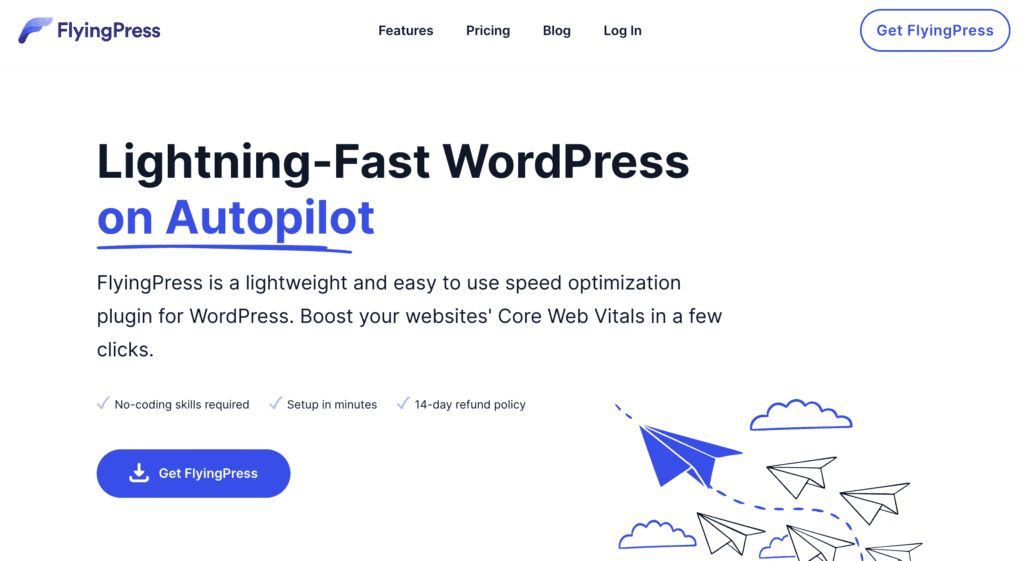
FlyingPress, over the years, has established a place for itself as a trusted tool in WordPress website optimization. Initially created to address the growing need for faster and more responsive websites, it didn’t take long for FlyingPress to rise in popularity. Its expansive suite of features promises not only speed but also efficiency.
Here are some of its standout settings:
- Image loading optimization
- Google Fonts tuning
- Cache preloading
- Static file minification
- JavaScript
- CSS minification
- Database optimization
- Remove unused CSS
- Bloat control
- CDN integration
- Delay JavaScript Loading
Thanks to these features, FlyingPress has gained recognition and helped countless websites achieve their optimal performance. If you’re looking for a tool that combines the best of both worlds – speed and efficiency – then FlyingPress is worth a closer look.
Revealing the Best FlyingPress Settings
Optimizing a website can be a complex process, but getting the correct settings in place is crucial. In this section, we’ll break down the best FlyingPress settings to help your website perform at its peak and meet Google’s Core Web Vitals standards.
Cache Settings

Caching is a bit like a website’s memory bank. Imagine if every time you visited a site, it had to rebuild itself from scratch. That would take ages to load, and that’s where caching steps in.
It speeds things up by storing the parts of a website for easy access, offering visitors a smooth experience. Here’s why caching is so important for good website performance:
- Quick loads: With caching, a website can show content faster. That’s because it reuses stored info instead of starting over.
- Happy visitors: A quick website leads to more satisfied visitors who are more likely to stay.
Best Ways to Set It Up
Setting up caching might seem tricky, but with the right steps, it’s a breeze. Let’s dive into the best methods to get it running smoothly on your website.
- Cache logged-in users: For regular blogs, you don’t need this, so you should turn it off. However, consider turning it on if you have a subscription or member-based site.
- Automatically preload cache: Preload the entire cache after saving settings and other relevant events. It could be activated for single websites installations.
- Preload links on hover: You should turn it on because it’s great for enhancing user feel.
- Scheduled preload: This feature isn’t essential to turn on right away. If you encounter problems related to cache, consider setting it to refresh every 12 or 24 hours.
CSS Settings
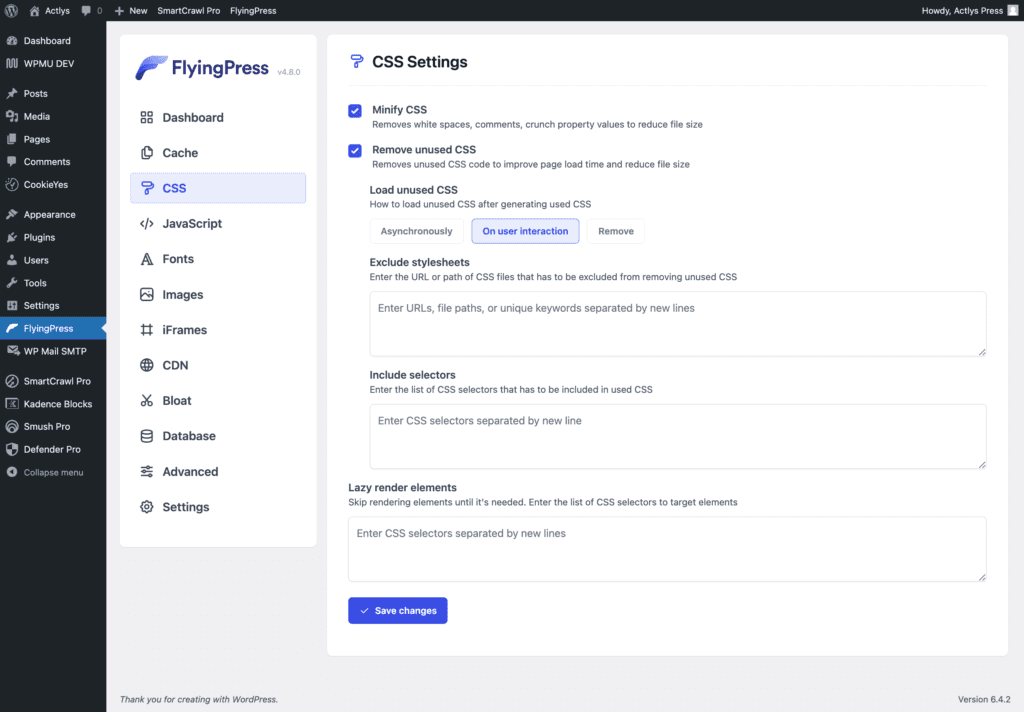
Have you ever noticed some websites have striking designs with cool animations and fancy effects? That’s often thanks to CSS or Cascading Style Sheets.
Still, while CSS makes websites look great, it can also slow them down. Think of it like putting on a heavy costume for a play. It might look amazing, but it can make it harder to move around.
Now, the challenge is to have a website that looks amazing and runs fast. That’s where FlyingPress comes in. CSS files tell your website how to look. However, if they are too large or not properly configured, they can slow down the loading time of your website.
Improving CSS with FlyingPress
FlyingPress offers features to help with this. Here’s how:
- Minify CSS: FlyingPress activates this setting by default. Minification strips away unneeded comments and spaces from the CSS documents. Doing this makes the file smaller, giving your website a speed bump.
- Remove unused CSS: It’s always wise to get rid of any CSS code that’s not in use. This not only makes your site run faster but also enhances those critical Core Web Vital scores.
- Load Unused CSS: Managing the unnecessary CSS is crucial, and FlyingPress provides three strategies:
- Asynchronously: This method ensures unused CSS loads in the background seamlessly, without any impact on the website’s initial load time.
- On User Interaction: A smart approach where the unused CSS only gets to work when there’s some form of user engagement, such as scrolling.
- Remove: This straightforward method purges the unused CSS, leading to both swifter loading and a leaner file size.
- Exclude Stylesheets: Recognizing the importance of certain stylesheets, FlyingPress allows for the pinpoint exclusion of essential CSS files. This ensures they remain unaffected when the unused CSS is being managed.
- Include Selectors: Available only when ‘remove unused CSS’ is selected, this feature provides a tailored solution. It permits the manual inclusion of specific selectors to be preserved in the optimized CSS, ensuring that even those selectors not automatically detected by FlyingPress are kept intact.
- Lazy render elements: This setting lets you selectively optimize how certain HTML elements appear. List out CSS selectors such as #comments, #bottom-section, #main-footer, etc. Once listed, the feature handles the rest, ensuring a smooth user experience.
JavaScript Settings
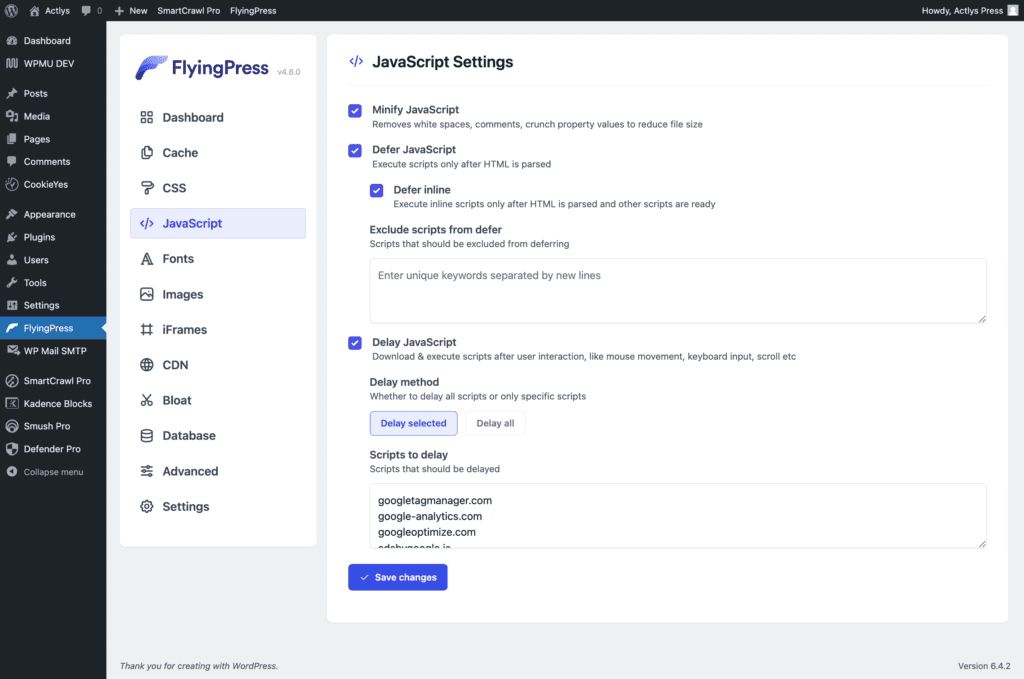
JavaScript (JS) is like magic for websites. It makes sites interactive, alive, and user-friendly. However, there’s a catch.
If not handled right, it can be the main reason your site feels like it’s slow instead of running everything quickly. Too much JS, or poorly optimized JavaScript, can seriously slow things down.
How FlyingPress Helps with JavaScript
FlyingPress knows this challenge and comes equipped with features to handle it:
- Minify JavaScript: Just like with CSS, FlyingPress can squeeze your JS files to make them smaller. It removes all the extra spaces and lines. This means your website has less to load, making it faster.
- Defer JavaScript: By deferring JS files, you can address issues where certain elements block the rendering of your page.
- Defer Inline: When activated, this option defers the loading of inline JavaScript scripts. This ensures they are executed only after the full HTML document is parsed, minimizing potential errors associated with premature script execution.
- Exclude Scripts from Defer: This feature becomes available when ‘Defer JavaScript’ is selected. It provides users the capability to specify particular scripts that should not be deferred, accommodating crucial scripts pivotal to the page’s functionality.
- Delay JavaScript: One of the best things you can do is delay the running of JavaScript until it’s really needed. FlyingPress has a feature that lets you do this. It ensures JS only runs when a user interacts with that part of the page.
- Delay Method: Users are presented with two options for script delay. “Delay Selected” allows precise specification of which scripts to delay, whereas “Delay All” initiates a blanket delay on all scripts, excluding those identified in the “Exclude scripts from Delay.”
- Scripts to Delay: This setting is visible when “Delay JavaScript” is chosen. It offers users the ability to determine specific scripts for delay. By postponing script execution until there’s user interaction, it enhances page load time and optimizes performance.
Font Settings
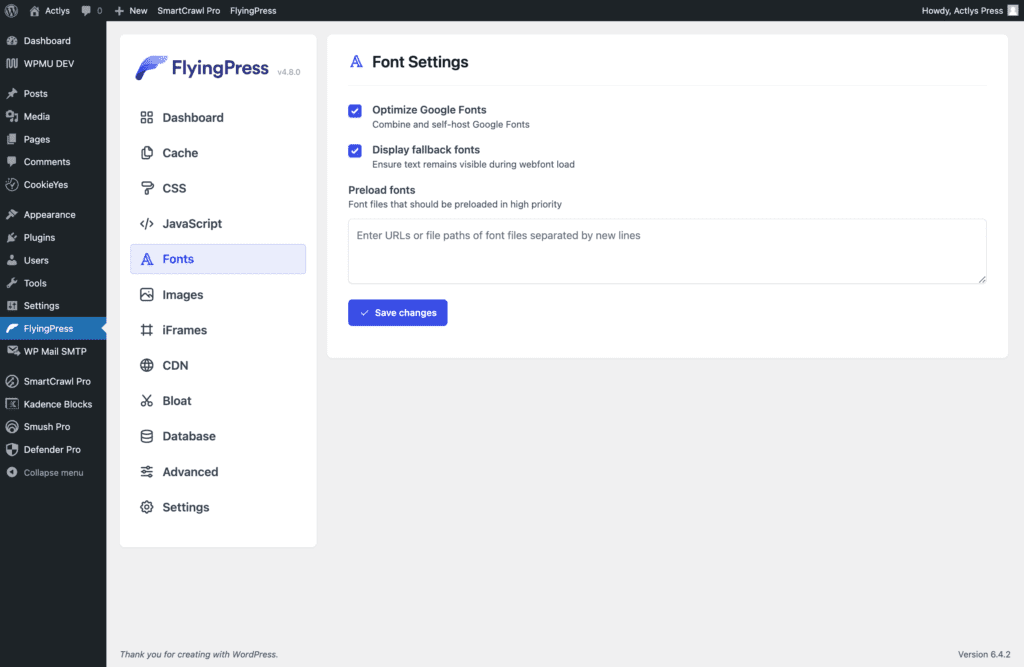
Fonts play a significant role in how a website feels. Think of them like the style of clothes you wear. Just like wearing heavy boots on a beach would be inappropriate, using fonts that look fancy but slow down your site can also be a wrong choice.
Nonetheless, here’s the challenge: some of the most stylish fonts can be bulky, causing a site to drag.
FlyingPress as Solution
This amazing tool knows this challenge and offers a smart solution. Here’s what it offers:
- Optimize Google Fonts: You should turn it on. When embedding Google Fonts in WordPress, the server is prompted for more requests, which can slow down loading times. By activating this feature, FlyingPress will handle Google Fonts directly. If you aren’t using any outside fonts, just leave it like this.
- Display fallback fonts: By enabling this setting, it inserts a font-display: swap into the CSS code. This ensures that the text remains visible to the user while the main webfont is loading.
- Preload fonts: If you store fonts on your server, this setting helps them show up faster. Add your font links, and you can speed up multiple fonts this way. It also works for fonts from other places as well.
Image Settings
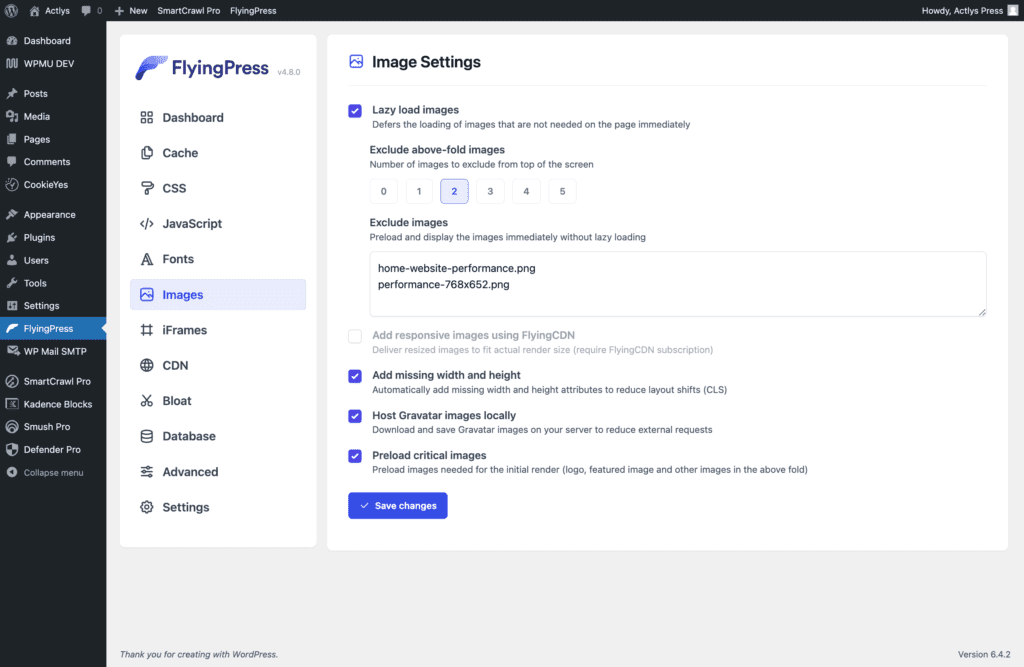
Pictures add life to a website, making it attractive and engaging. However, large image files can be the main reason a webpage loads forever. If you’ve ever left a website because the pictures took too long to appear, you know what we’re talking about.
Quality Vs. Speed: Finding the Balance
Thankfully, we don’t have to choose between gorgeous images and speedy websites. The key is to find a middle ground. Here’s how:
- Lazy load images: Turn this on for a smoother experience, especially when your post is rich with pictures. Additionally, this option means only loading the photos when they’re about to show on the screen. The images at the bottom won’t load if someone doesn’t scroll down, which saves a lot of time!
- Exclude above-fold images: This option ensures the initial images your visitor sees, such as logos or the primary post image, appear first. Let two or three images load instantly to keep your site looking snappy.
- Add responsive images using FyingCDN: Turn this on if you’re a FlyingCDN subscriber. It’s a big plus for mobile site optimization.
- Add missing width and height: It is always a good idea to set width and height to avoid unexpected shifts in your layout. You’ll keep your site consistent and neat by switching this on.
- Host Gravatar images locally: By keeping Gravatar images on your own server, you can reduce requests to third-party sites. This strategy can significantly enhance your page’s load speed.
- Preload critical images: Once activated, FlyingPress swiftly loads above-the-fold pictures. Moreover, this option improves your LCP score and makes your site’s visual presentation faster and more efficient.
FlyingPress understands the importance of images. It offers settings that let you control how pictures are handled, ensuring they look great but don’t slow things down.
iFrame Settings
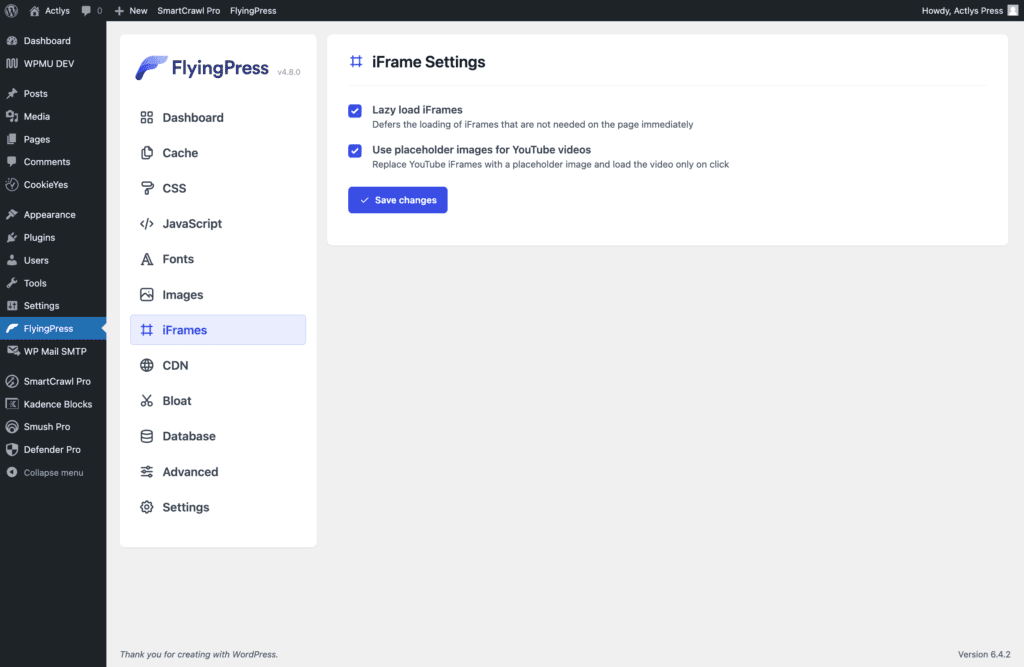
When you pop an iFrame into your website, it’s like opening a window to another site. Think of it like having a YouTube video or a Facebook post live on your page. However, these iFrames can sometimes make your website drag its feet, making things slower for your visitors.
Here are the two features FlyingPress offers for iFrame optimization, ensuring that your embedded content is both efficient and user-friendly.
- Lazy load iFrames: By turning this feature on, you’ll set iFrames to load in a ‘lazy’ manner. This is beneficial for things such as embedded Google Maps or YouTube videos. The essence here is to load these embeds only when the user interacts with them, enhancing the page’s speed.
- Use placeholder images for YouTube videos: Rather than directly fetching video thumbnails from YouTube, you can use a preset image as a placeholder. This method reduces the number of requests made to YouTube, streamlining the embedding process.
CDN Settings
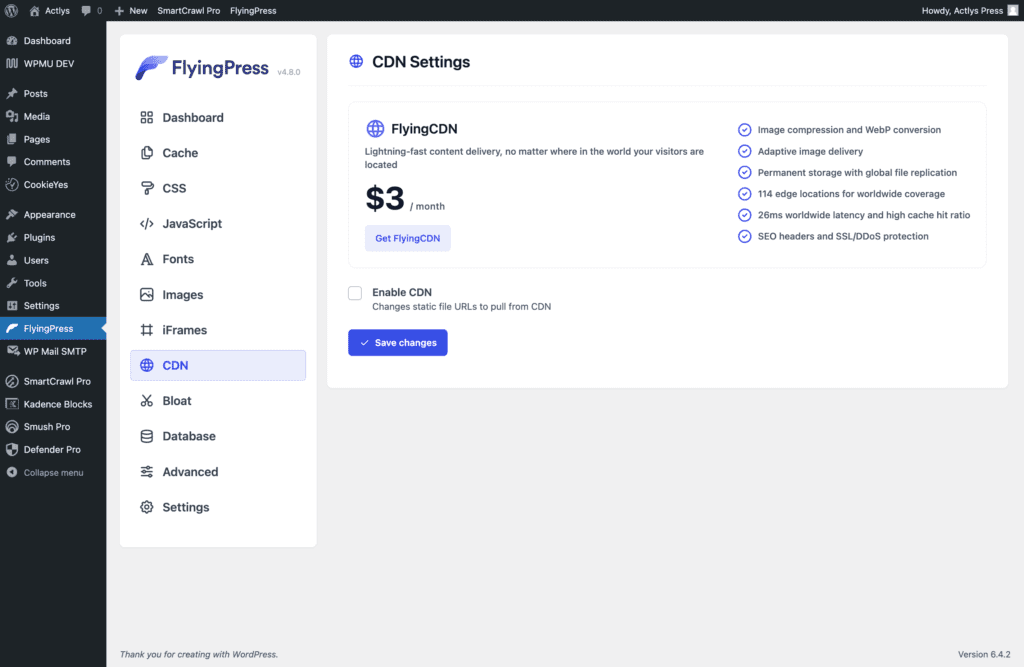
Adjusting the way files are delivered can speed up your website, and that’s where a CDN (Content Delivery Network) comes in. Let’s explore these options with FlyingPress.
FlyingPress boasts its own speedy delivery network, precisely named FlyingCDN. Also, don’t worry if you already use another CDN provider because you can still join FlyingCDN. Simply pop in your CDN URL and specify the file types to be transferred through your CDN.
If your site is receiving a significant number of visitors, combining FlyingCDN with Cloudflare can work well. Regardless of your chosen CDN provider, the setup process remains unchanged.
Bloat Settings

We all love adding cool features to our websites. Fancy sliders, multiple widgets, and various animations might look great, but they often slow things down. Sometimes, we don’t even realize how much we’ve added to our site. The key is to recognize what you don’t need.
How FlyingPress Helps Cut the Extra Weight
The bloat settings are not just about speeding up what you have but also about identifying what to let go. Here are the recommended settings to reduce bloat:
- Remove Google Fonts: If you are using fonts from an external source, you should activate this feature. Otherwise, it should be disabled. This setting will exclude all Google Fonts from your site.
- Disable WooCommerce cart fragments: This helps boost the speed of your online store, so you should enable it.
- Disable WooCommerce assets: With this activated, WooCommerce scripts will only load on their respective pages, making your site faster.
- Disable XML-RPC: While XML-RPC lets you post from mobile, it isn’t the fastest or most secure. Many choose to turn it off.
- Disable RSS feed: If your site doesn’t feature a blog, you won’t need an RSS feed. Only activate if you regularly post articles.
- Disable block editor CSS: You should keep it off for the Gutenberg editor. However, if using page builders such as Elementor, turn it on.
- Disable oEmbeds: Activate this if you don’t require WordPress previews for YouTube or Twitter links.
- Disable emojis: Activating this reduces some JavaScript codes on your site.
- Disable WP Cron: WP Cron is essential for smooth website operations. However, if you’ve set up cron tasks externally, you can turn off this feature.
- Disable jQuery migration: If using tools such as Divi Builder, ensure jQuery remains active. Another strategy is simply using faster plugins.
- Disable dashicons: If enabled, this setting reduces the loading of unnecessary CSS files linked to admin icons.
- Control post revisions: You should enable five revisions. Regularly clear older post versions to streamline the database.
- Control heartbeat: It should be disabled while editing your posts. Don’t switch off the heartbeat completely. Instead, adjusting it to 60 seconds during edits is sufficient.
Database Settings
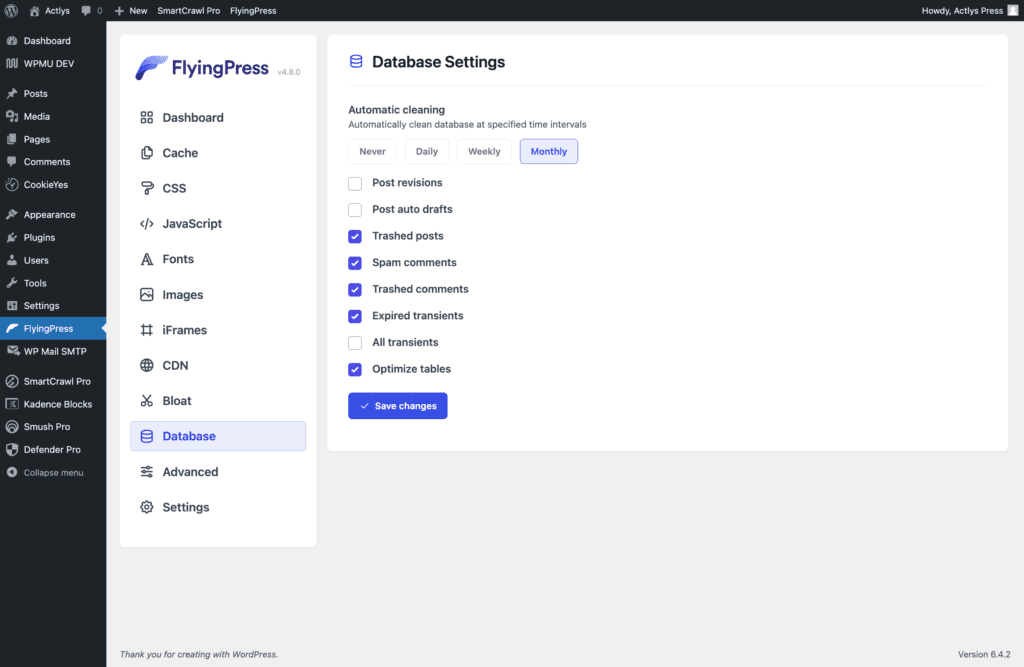
A website’s database stores a lot of information, including posts, comments, user details, and settings. As the website grows, so does the amount of stored data. However, not all of it is always useful.
Old data, such as outdated revisions, unused tags, or settings from deleted plugins, can accumulate. This accumulation slows down the website, as it has to process more data to serve its content.
How FlyingPress Helps
FlyingPress offers easy-to-use tools for cleaning your database. With just a few clicks, you can eliminate the unneeded stuff. Here’s how it can help:
- Automatic cleaning: Set it to a weekly time interval. It’s a good practice to tidy up your database more often. Hence, turning on the automatic cleanup is a must.
- Post revisions: Use this feature if you frequently edit articles and appreciate having multiple versions saved. However, if your site is straightforward with just a single page, you might turn this off.
- Post auto drafts: Cleaning up automatically saved drafts is unnecessary, so switching this feature off is best.
- Trashed posts: If you prefer to remove trashed articles from your site automatically, ensure this is activated.
- Spam comments: With this on, unwanted comments labeled as spam are automatically discarded.
- Trashed comments: This ensures comments you’ve thrown away don’t stick around.
- Expired transients: As outdated temporary data is useless, activate this feature to clear it out.
- All transients: Getting rid of temporary data won’t harm your site. Therefore, it’s advisable to turn this on.
- Optimize tables: Regular database maintenance is vital to a fast website. Activate this feature to achieve it.
Regularly using these tools ensures your website’s database remains tidy. With a well-maintained database, your site loads faster, offering a better experience for visitors. Remember, a clean database is a fast one!
Advanced Settings
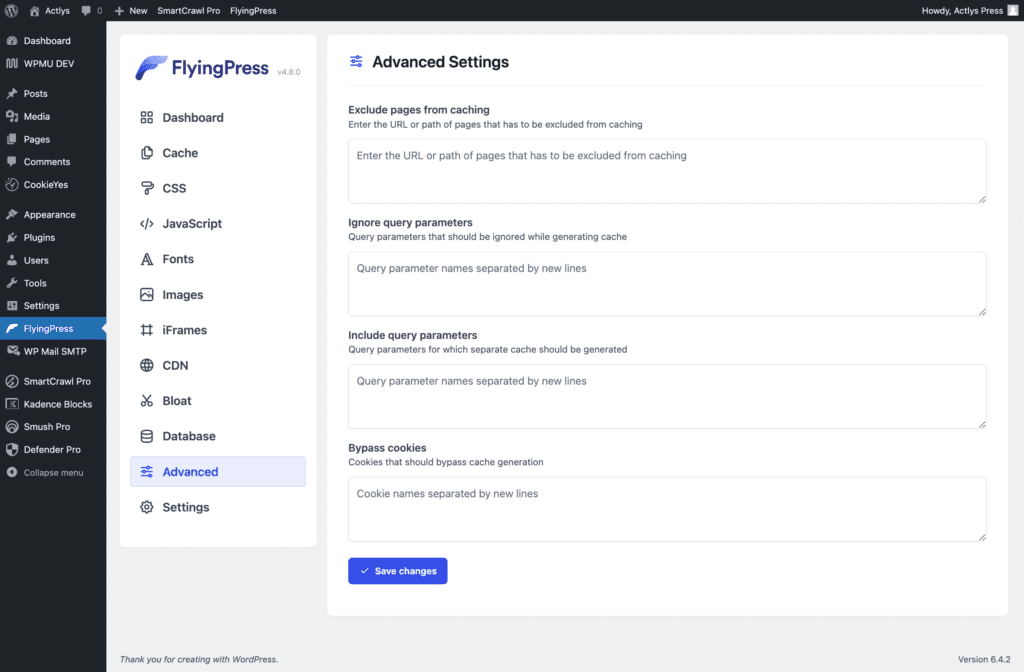
- Exclude pages from caching: Not every page needs caching. With FlyingPress, you can pick which pages to cache and which to skip.
- Ignore query parameters: Some URL parameters are already ignored by FlyingPress. If you’ve got a marketing campaign and want its specific parameters untouched, list them in this area.
- Include query parameters: When you want a separate cache, just add parameters. It’s handy for e-commerce, search, and similar stuff.
- Bypass cookies: It’s generally not necessary to activate this option.
Closing Thoughts
Nowadays, having a fast website isn’t just a luxury but a necessity. Every millisecond counts when users are browsing, and a slow site can drive them away. FlyingPress offers a well-rounded solution, ensuring your website performs at its best from every angle.
However, remember, your website isn’t a set-it-and-forget-it thing. It’s essential to consistently update plugins and stay informed about the latest web standards.
While FlyingPress operates well on its own, pairing it with other performance tools can supercharge your site even further. Let’s prioritize speed and provide your users with the quick and seamless experience they deserve.
Also, if you’ve bogged down with the FlyingPress settings, don’t hesitate to reach out to us. Our experienced team can guide you through the process, ensuring your website passes Core Web Vitals and achieves peak performance.







